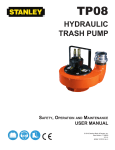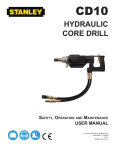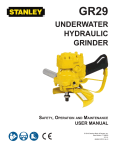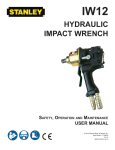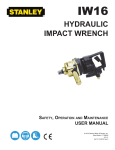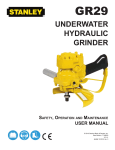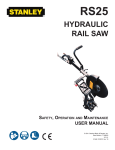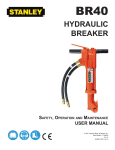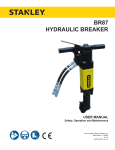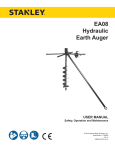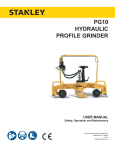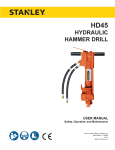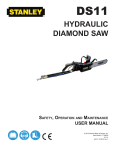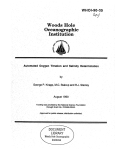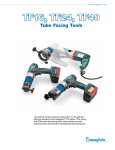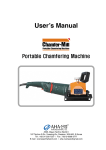Download Hydraulic Hammer drill
Transcript
HD08 Hydraulic Hammer Drill Safety, Operation and Maintenance USER MANUAL © 2011 Stanley Black & Decker, Inc. New Britain, CT 06053 U.S.A. 65301 2/2011 Ver. 4 DECLARATION OF CONFORMITY declaratioN oF coNFormity ÜBereiNStimmuNGS-erKlaruNG declaratioN de coNFormite cee declaracioN de coNFormidad dicHiaraZioNe di coNFormita Hydraulic tools ______________________________________________________________________ I, the undersigned: Ich, der Unterzeichnende: Je soussigné: El abajo firmante: lo sottoscritto: Weisbeck, andy Surname and First names/Familiennname und Vornamen/Nom et prénom/Nombre y apellido/Cognome e nome hereby declare that the equipment specified hereunder: bestätige hiermit, daß erklaren Produkt genannten Werk oder Gerät: déclare que l’équipement visé ci-dessous: Por la presente declaro que el equipo se especifica a continuación: dichiaro che le apparecchiature specificate di seguito: 1. Category: Kategorie: Catégorie: Categoria: Categoria: Hammer drill, Hydraulic 2. Make/Marke/Marque/Marca/Marca Stanley 3. Type/Typ/Type/Tipo/Tipo: HD0853101 4. Serial number of equipment: Seriennummer des Geräts: Numéro de série de l’équipement: Numero de serie del equipo: Matricola dell´attrezzatura: all Has been manufactured in conformity with Wurde hergestellt in Übereinstimmung mit est fabriqué conformément Ha sido fabricado de acuerdo con e’ stata costruita in conformitá con Directive/Standards Richtlinie/Standards Directives/Normes Directriz/Los Normas Direttiva/Norme No. Nr Numéro No n. Approved body Prüfung durch Organisme agréé Aprobado Collaudato EN ISO ISO ISO Machinery Directive EN ISO 3744:2009 792-5:1994 8662-3:1992 2006/42/EC:2006 12100-1, 12100-2:2009 Self Self Self Self Self 5. Special Provisions: None Spezielle Bestimmungen: Dispositions particulières: Provisiones especiales: Disposizioni speciali: 6. Representative in the Union: Patrick Vervier, Stanley Dubuis 17-19, rue Jules Berthonneau-BP 3406 41034 Blois Cedex, France. Vertreter in der Union/Représentant dans l’union/Representante en la Union/Rappresentante presso l’Unione Done at/Ort/Fait à/Dado en/Fatto a Stanley Hydraulic Tools, Milwaukie, Oregon USA Signature/Unterschrift/Signature/Firma/Firma Position/Position/Fonction/Cargo/Posizione 1/10/2011 2 ► HD08 User Manual Engineering Manager Date/Datum/le/Fecha/Data 1-10-11 TABLE OF CONTENTS DECLARATION OF CONFORMITY...........................................................................................................................2 SAFETY SYMBOLS...................................................................................................................................................4 SAFETY PRECAUTIONS...........................................................................................................................................5 TOOL STICKERS & TAGS.........................................................................................................................................6 HOSE TYPES.............................................................................................................................................................7 HOSE RECOMMENDATIONS...................................................................................................................................8 Figure 1. Typical Hose Connections........................................................................................................8 HTMA REQUIREMENTS............................................................................................................................................9 Operation.............................................................................................................................................................10 Figure 2. Operator Controls...................................................................................................................10 Figure 3. Hammer Drill Accessories...................................................................................................... 11 TOOL PROTECTION & CARE.................................................................................................................................13 TROUBLESHOOTING.............................................................................................................................................14 SPECIFICATIONS....................................................................................................................................................16 Accessories.......................................................................................................................................................16 Service Parts.....................................................................................................................................................16 HD08 PARTS ILLUSTRATION.................................................................................................................................17 HD08 PARTS LIST...................................................................................................................................................18 IMPORTANT To fill out a Product Warranty Recording form, and for information on your warranty, visit Stanleyhydraulic.com and select the Warranty tab. (Note: the warranty recording form must be submitted to validate the warranty). SERVICING THE STANLEY HYDRAULIC HAMMER DRILL. This manual contains safety, operation, and routine maintenance instructions. Stanley Hydraulic Tools recommends that servicing of hydraulic tools, other than routine maintenance, must be performed by an authorized and certified dealer. Please read the following warning. WARNING SERIOUS INJURY OR DEATH COULD RESULT FROM THE IMPROPER REPAIR OR SERVICE OF THIS TOOL. REPAIRS AND / OR SERVICE TO THIS TOOL MUST ONLY BE DONE BY AN AUTHORIZED AND CERTIFIED DEALER. For the nearest authorized and certified dealer, call Stanley Hydraulic Tools at the number listed on the back of this manual and ask for a Customer Service Representative. HD08 User Manual ◄ 3 SAFETY SYMBOLS Safety symbols and signal words, as shown below, are used to emphasize all operator, maintenance and repair actions which, if not strictly followed, could result in a life-threatening situation, bodily injury or damage to equipment. This is the safety alert symbol. It is used to alert you to potential personal injury hazards. Obey all safety messages that follow this symbol to avoid possible injury or death. DANGER This safety alert and signal word indicate an imminently hazardous situation which, if not avoided, will result in death or serious injury. WARNING This safety alert and signal word indicate a potentially hazardous situation which, if not avoided, could result in death or serious injury. CAUTION This safety alert and signal word indicate a potentially hazardous situation which, if not avoided, could result in death or serious injury. CAUTION This signal word indicates a potentially hazardous situation which, if not avoided, may result in property damage. NOTICE This signal word indicates a situation which, if not avoided, will result in damage to the equipment. IMPORTANT This signal word indicates a situation which, if not avoided, may result in damage to the equipment. Always observe safety symbols. They are included for your safety and for the protection of the tool. LOCAL SAFETY REGULATIONS Enter any local safety regulations here. Keep these instructions in an area accessible to the operator and maintenance personnel. 4 ► HD08 User Manual SAFETY PRECAUTIONS Tool operators and maintenance personnel must always comply with the safety precautions given in this manual and on the stickers and tags attached to the tool and hose. • Do not operate the tool at oil temperatures above 140 °F/60 °C. Operation at higher temperatures can cause higher than normal temperatures at the tool which can result in operator discomfort. These safety precautions are given for your safety. Review them carefully before operating the tool and before performing general maintenance or repairs. • Do not operate a damaged, improperly adjusted, or incompletely assembled hammer drill. • Never wear loose clothing that can get entangled in the working parts of the tool. • Keep all parts of your body away from the drill and maintain proper footing and balance at all times. • When working near electrical conductors, always assume that all conductors are energized and that insulation, clothing and hoses can conduct electricity. Stay a safe distance away from electrical conductors. • If the hydraulic power supply has been interrupted, place the hammer drill in the OFF position before restarting the hydraulic power supply. • To avoid personal injury or equipment damage, all tool repair, maintenance and service must only be performed by authorized and properly trained personnel. Supervising personnel should develop additional precautions relating to the specific work area and local safety regulations. If so, place the added precautions in the space provided in this manual. The model HD08 Hydraulic Hammer Drill will provide safe and dependable service if operated in accordance with the instructions given in this manual. Read and understand this manual and any stickers and tags attached to the tool and hose before operation. Failure to do so could result in personal injury or equipment damage. • The operator must start in a work area without bystanders. Flying debris can cause serious injury. • Do not operate the tool unless thoroughly trained or under the supervision of an instructor. Establish a training program for all operators to ensure safe operation. • Always wear safety equipment such as goggles, ear and head protection, and safety shoes at all times when operating the tool. Use gloves and aprons when necessary. • The operator must be familiar with all prohibited work areas such as excessive slopes and dangerous terrain conditions. • Do not inspect, clean or replace any part(s) if the hydraulic power source is connected. Do not inspect or clean the tool while the hydraulic power source is connected. Accidental engagement of the tool can cause serious injury. • Always connect hoses to the tool hose couplers before energizing the hydraulic power source. Be sure all hose connections are tight and are in good condition. HD08 User Manual ◄ 5 TOOL STICKERS & TAGS Stanley Hydraulic Tools 3810 SE Naef Road Milwaukie, OR 97267 ELECTROCUTION HAZARD Failure to use hydraulic hose labeled and certified as non-conductive when using hydraulic tools on or near electric lines may result in death or serious injury. For proper and safe operation read owners manual and make sure that you have been properly trained in correct procedures required for work on or around electric lines. 17179 Stanley Decal 17160 Electrical Danger Decal 28788 Manual Decal 28323 CE Decal Staney Hydraulic Tools 3810 SE Naef Road Miwaukie, OR 97267 Model No.: HD08 CAUTION 15-34 LPM/4-9 GPM DO NOT EXCEED 140 BAR/2000 PSI DO NOT EXCEED SPECIFIED FLOW OR PRESSURE. USE CLOSED-CENTER TOOL ON CLOSED-CENTER SYSTEM. USE OPEN-CENTER TOOL ON OPEN-CENTER SYSTEM. CORRECTLY CONNECT HOSES TO TOOL "IN" AND "OUT" PORTS. 11354 OC/CC Decal IMPROPER HANDLING, USE OR MAINTENANCE OF 22796 Sound Power Level Decal TOOL COULD RESULT IN A LEAK, BURST OR OTHER TOOL FAILURE. CONTACT AT A LEAK OR BURST CAN CAUSE OIL INJECTION INTO THE BODY. FAILURE TO OBSERVE THESE PRECAUTIONS CAN RESULT IN SERIOUS PERSONAL INJURY. 17161 HD08 Name Tag/GPM Decal D 30 LPM @ 138 B AR EHTMA CATEGORY C C 11207 Circuit D Decal C 11206 Circuit C Decal 17162 OC/CC Decal NOTE: THE INFORMATION LISTED ON THE STICKERS SHOWN, MUST BE LEGIBLE AT ALL TIMES. REPLACE DECALS IF THEY BECOME WORN OR DAMAGED. REPLACEMENTS ARE AVAILABLE FROM YOUR LOCAL STANLEY DISTRIBUTOR. The safety tag (p/n 15875) at right is attached to the tool when shipped from the factory. Read and understand the safety instructions listed on this tag before removal. We suggest you retain this tag and attach it to the tool when not in use. DA N G ER 1. FAILURE TO USE HYDRAULIC HOSE LABELED AND CERTIFIED AS NON-CONDUCTIVE WHEN USING HYDRAULIC TOOLS ON OR NEAR ELECTRICAL LINES MAY RESULT IN DEATH OR SERIOUS INJURY. BEFORE USING HOSE LABELED AND CERTIFIED AS NONCONDUCTIVE ON OR NEAR ELECTRIC LINES BE SURE THE HOSE IS MAINTAINED AS NON-CONDUCTIVE. THE HOSE SHOULD BE REGULARLY TESTED FOR ELECTRIC CURRENT LEAKAGE IN ACCORDANCE WITH YOUR SAFETY DEPARTMENT INSTRUCTIONS. 2. A HYDRAULIC LEAK OR BURST MAY CAUSE OIL INJECTION INTO THE BODY OR CAUSE OTHER SEVERE PERSONAL INJURY. A. DO NOT EXCEED SPECIFIED FLOW AND PRESSURE FOR THIS TOOL. EXCESS FLOW OR PRESSURE MAY CAUSE A LEAK OR BURST. B. DO NOT EXCEED RATED WORKING PRESSURE OF HYDRAULIC HOSE USED WITH THIS TOOL. EXCESS PRESSURE MAY CAUSE A LEAK OR BURST. C. CHECK TOOL HOSE COUPLERS AND CONNECTORS DAILY FOR LEAKS. DO NOT FEEL FOR LEAKS WITH YOUR HANDS. CONTACT WITH A LEAK MAY RESULT IN SEVERE PERSONAL INJURY. DA N G ER D. DO NOT LIFT OR CARRY TOOL BY THE HOSES. DO NOT ABUSE HOSE. DO NOT USE KINKED, TORN OR DAMAGED HOSE. 3. MAKE SURE HYDRAULIC HOSES ARE PROPERLY CONNECTED TO THE TOOL BEFORE PRESSURING SYSTEM. SYSTEM PRESSURE HOSE MUST ALWAYS BE CONNECTED TO TOOL “IN” PORT. SYSTEM RETURN HOSE MUST ALWAYS BE CONNECTED TO TOOL “OUT” PORT. REVERSING CONNECTIONS MAY CAUSE REVERSE TOOL OPERATION WHICH CAN RESULT IN SEVERE PERSONAL INJURY. 4. DO NOT CONNECT OPEN-CENTER TOOLS TO CLOSEDCENTER HYDRAULIC SYSTEMS. THIS MAY RESULT IN LOSS OF OTHER HYDRAULIC FUNCTIONS POWERED BY THE SAME SYSTEM AND/OR SEVERE PERSONAL INJURY. 5. BYSTANDERS MAY BE INJURED IN YOUR WORK AREA. KEEP BYSTANDERS CLEAR OF YOUR WORK AREA. 6. WEAR HEARING, EYE, FOOT, HAND AND HEAD PROTECTION. 7. TO AVOID PERSONAL INJURY OR EQUIPMENT DAMAGE, ALL TOOL REPAIR MAINTENANCE AND SERVICE MUST ONLY BE PERFORMED BY AUTHORIZED AND PROPERLY TRAINED PERSONNEL. IM P ORTA N T IM P ORTA N T READ OPERATION MANUAL AND SAFETY INSTRUCTIONS FOR THIS TOOL BEFORE USING IT. READ OPERATION MANUAL AND SAFETY INSTRUCTIONS FOR THIS TOOL BEFORE USING IT. USE ONLY PARTS AND REPAIR PROCEDURES APPROVED BY STANLEY AND DESCRIBED IN THE OPERATION MANUAL. USE ONLY PARTS AND REPAIR PROCEDURES APPROVED BY STANLEY AND DESCRIBED IN THE OPERATION MANUAL. TAG TO BE REMOVED ONLY BY TOOL OPERATOR. TAG TO BE REMOVED ONLY BY TOOL OPERATOR. SEE OTHER SIDE SEE OTHER SIDE SAFETY TAG P/N 15875 (Shown smaller then actual size) 6 ► HD08 User Manual HOSE TYPES The rated working pressure of the hydraulic hose must be equal to or higher than the relief valve setting on the hydraulic system. There are three types of hydraulic hose that meet this requirement and are authorized for use with Stanley Hydraulic Tools. They are: Certified non-conductive — constructed of thermoplastic or synthetic rubber inner tube, synthetic fiber braid reinforcement, and weather resistant thermoplastic or synthetic rubber cover. Hose labeled certified nonconductive is the only hose authorized for use near electrical conductors. Wire-braided (conductive) — constructed of synthetic rubber inner tube, single or double wire braid reinforcement, and weather resistant synthetic rubber cover. This hose is conductive and must never be used near electrical conductors. Fabric-braided (not certified or labeled non-conductive) — constructed of thermoplastic or synthetic rubber inner tube, synthetic fiber braid reinforcement, and weather resistant thermoplastic or synthetic rubber cover. This hose is not certified non-conductive and must never be used near electrical conductors. hOSE SAFETY TAGS To help ensure your safety, the following DANGER tags are attached to all hose purchased from Stanley Hydraulic Tools. DO NOT REMOVE THESE TAGS. If the information on a tag is illegible because of wear or damage, replace the tag immediately. A new tag may be obtained from your Stanley Distributor. DA N G ER DA N G ER 1. FAILURE TO USE HYDRAULIC HOSE LABELED AND CERTIFIED AS NON-CONDUCTIVE WHEN USING HYDRAULIC TOOLS ON OR NEAR ELECTRIC LINES MAY RESULT IN DEATH OR SERIOUS INJURY. FOR PROPER AND SAFE OPERATION MAKE SURE THAT YOU HAVE BEEN PROPERLY TRAINED IN CORRECT PROCEDURES REQUIRED FOR WORK ON OR AROUND ELECTRIC LINES. 2. BEFORE USING HYDRAULIC HOSE LABELED AND CERTIFIED AS NON-CONDUCTIVE ON OR NEAR ELECTRIC LINES. WIPE THE ENTIRE LENGTH OF THE HOSE AND FITTING WITH A CLEAN DRY ABSORBENT CLOTH TO REMOVE DIRT AND MOISTURE AND TEST HOSE FOR MAXIMUM ALLOWABLE CURRENT LEAKAGE IN ACCORDANCE WITH SAFETY DEPARTMENT INSTRUCTIONS. 3. DO NOT EXCEED HOSE WORKING PRESSURE OR ABUSE HOSE. IMPROPER USE OR HANDLING OF HOSE COULD RESULT IN BURST OR OTHER HOSE FAILURE. KEEP HOSE AS FAR AWAY AS POSSIBLE FROM BODY AND DO NOT PERMIT DIRECT CONTACT DURING USE. CONTACT AT THE BURST CAN CAUSE BODILY INJECTION AND SEVERE PERSONAL INJURY. 4. HANDLE AND ROUTE HOSE CAREFULLY TO AVOID KINKING, ABRASION, CUTTING, OR CONTACT WITH HIGH TEMPERATURE SURFACES. DO NOT USE IF KINKED. DO NOT USE HOSE TO PULL OR LIFT TOOLS, POWER UNITS, ETC. 5. CHECK ENTIRE HOSE FOR CUTS CRACKS LEAKS ABRASIONS, BULGES, OR DAMAGE TO COUPLINGS IF ANY OF THESE CONDITIONS EXIST, REPLACE THE HOSE IMMEDIATELY. NEVER USE TAPE OR ANY DEVICE TO ATTEMPT TO MEND THE HOSE. 6. AFTER EACH USE STORE IN A CLEAN DRY AREA. SEE OTHER SIDE SIDE 1 SEE OTHER SIDE (Shown smaller than actual size) DO NOT REMOVE THIS TAG DO NOT REMOVE THIS TAG The tag shown below is attached to “certified non-conductive” hose SIDE 2 DA N G ER DA N G ER 1. DO NOT USE THIS HYDRAULIC HOSE ON OR NEAR ELECTRIC LINES. THIS HOSE IS NOT LABELED OR CERTIFIED AS NON-CONDUCTIVE. USING THIS HOSE ON OR NEAR ELECTRICAL LINES MAY RESULT IN DEATH OR SERIOUS INJURY. 5. CHECK ENTIRE HOSE FOR CUTS CRACKS LEAKS ABRASIONS, BULGES, OR DAMAGE TO COUPLINGS IF ANY OF THESE CONDITIONS EXIST, REPLACE THE HOSE IMMEDIATELY. NEVER USE TAPE OR ANY DEVICE TO ATTEMPT TO MEND THE HOSE. 2. FOR PROPER AND SAFE OPERATION MAKE SURE THAT YOU HAVE BEEN PROPERLY TRAINED IN CORRECT PROCEDURES REQUIRED FOR WORK ON OR AROUND ELECTRIC LINES. 6. AFTER EACH USE STORE IN A CLEAN DRY AREA. 3. DO NOT EXCEED HOSE WORKING PRESSURE OR ABUSE HOSE. IMPROPER USE OR HANDLING OF HOSE COULD RESULT IN BURST OR OTHER HOSE FAILURE. KEEP HOSE AS FAR AWAY AS POSSIBLE FROM BODY AND DO NOT PERMIT DIRECT CONTACT DURING USE. CONTACT AT THE BURST CAN CAUSE BODILY INJECTION AND SEVERE PERSONAL INJURY. 4. HANDLE AND ROUTE HOSE CAREFULLY TO AVOID KINKING, CUTTING, OR CONTACT WITH HIGH TEMPERATURE SURFACES. DO NOT USE IF KINKED. DO NOT USE HOSE TO PULL OR LIFT TOOLS, POWER UNITS, ETC. DO NOT REMOVE THIS TAG DO NOT REMOVE THIS TAG The tag shown below is attached to “conductive” hose. SEE OTHER SIDE SEE OTHER SIDE SIDE 1 SIDE 2 (Shown smaller than actual size) HD08 User Manual ◄ 7 8 ► HD08 User Manual All hydraulic hose must meet or exceed specifications as set forth by SAE J517. All hydraulic hose must have at least a rated minimum working pressure equal to the maximum hydraulic system relief valve setting. This chart is intended to be used for hydraulic tool applications only based on Stanley Hydraulic Tools tool operating requirements and should not be used for any other applications. The chart to the right shows recommended minimum hose diameters for various hose lengths based on gallons per minute (gpm)/ liters per minute (lpm). These recommendations are intended to keep return line pressure (back pressure) to a minimum acceptable level to ensure maximum tool performance. Tool to Hydraulic Circuit Hose Recommendations 15-34 MM Inside Diameter INCH USE (Press/Return) PSI up to 10 up to 3 3/8 10 Both 2250 49-60 13-16 FLOW >>> RETURN <<< FLOW PRESSURE 26-100 up to 25 100-200 51-100 up to 50 100-300 51-100 up to 50 26-100 up to 25 8-30 up to 8 30-60 15-30 up to 15 30-90 15-30 up to 15 7.5-30 up to 7.5 Figure 1. Typical Hose Connections 49-60 13-16 38-49 10-13 38-49 19-40 5-10.5 10-13 19-40 5-10.5 38-49 19-40 5-10.5 10-13 15-23 15-23 4-6 3/8 10 19 19 25.4 3/4 1 16 5/8 3/4 19 25.4 1 19 3/4 3/4 16 16 5/8 16 19 5/8 3/4 5/8 16 13 13 5/8 1/2 1/2 Return Pressure Return Pressure Return Pressure Return Pressure Both Return Pressure Both Both Both Both 2500 2500 2500 2500 2500 2500 2500 2500 2500 2500 2500 2500 2500 2500 2500 175 175 175 175 175 175 175 175 175 175 175 175 175 175 175 155 BAR Min. Working Pressure Certified Non-Conductive Hose - Fiber Braid - for Utility Bucket Trucks METERS Hose Lengths FEET Conductive Hose - Wire Braid or Fiber Braid -DO NOT USE NEAR ELECTRICAL CONDUCTORS 4-6 4-9 LPM Oil Flow GPM HOSE RECOMMENDATIONS HTMA REQUIREMENTS TOOL CATEGORY HYDRAULIC SYSTEM REQUIREMENTS TYPE I TYPE II TYPE III TYPE RR Flow Rate 4–6 gpm (15–23 lpm) 7–9 gpm (26–34 lpm) 11–13 gpm (42–49 lpm) 9–10.5 gpm (34–40 lpm) Tool Operating Pressure (At the power supply outlet) 2000 psi (145–155 bar) 2000 psi (138 bar) 2000 psi (138 bar) 2000 psi (138 bar) System relief valve setting (At the power supply outlet) 2100–2250 psi (145–155 bar) 2100–2250 psi (145–155 bar) 2100–2250 psi (145–155 bar) 2200–2300 psi (145–155 bar) Maximum back pressure (At tool end of the return hose) 250 psi (17 bar) 250 psi (17 bar) 250 psi (17 bar) 250 psi (17 bar) Measured at a max. fluid viscosity of: (At min. operating temperature) 400 ssu* (82 centistokes) 400 ssu* 400 ssu* 400 ssu* (82 centistokes) (82 centistokes) (82 centistokes) Temperature Sufficient heat rejection capacity to limit max. fluid temperature to: (At max. expected ambient temperature) 140 °F (60 °C) 140 °F (60 °C) 140 °F (60 °C) 140 °F (60 °C) Min. cooling capacity at a temperature difference of between ambient and fluid temps 3 hp (2.24 kW) 40 °F (22 °C) 5 hp (3.73 kW) 40 °F (22 °C) 7 hp (4.47 kW) 40 °F (22 °C) 6 hp (5.22 kW) 40 °F (22 °C) NOTE: Do not operate the tool at oil temperatures above 140 °F (60 °C). Operation at higher temperatures can cause operator discomfort at the tool. Filter Min. full-flow filtration Sized for flow of at least: (For cold temp. start-up and max. dirt-holding capacity) 25 microns 30 gpm (114 lpm) 25 microns 30 gpm (114 lpm) 25 microns 30 gpm (114 lpm) 25 microns 30 gpm (114 lpm) Hydraulic fluid 100–400 ssu* 100–400 ssu* 100–400 ssu* 100–400 ssu* Petroleum based (Premium grade, anti-wear, non-conductive) Viscosity (At min. and max. operating temps) (20–82 centistokes) NOTE: When choosing hydraulic fluid, the expected oil temperature extremes that will be experienced in service determine the most suitable temperature viscosity characteristics. Hydraulic fluids with a viscosity index over 140 will meet the requirements over a wide range of operating temperatures. *SSU = Saybolt Seconds Universal HD08 User Manual ◄ 9 Operation PRE-OPERATION PROCEDURES CHECK POWER SOURCE 1. Using a calibrated flowmeter and pressure gauge, check that the hydraulic power source develops a flow of 4–9 gpm/15–34 lpm at 950–2000 psi/66–140 bar. If you are in doubt about the type, test the tool by connecting it to an open-center circuit with the trigger released. If pressure rises more in the circuit with the trigger released than when the trigger is pulled, the tool is closed-center. Open-center/Closed-center Selectable Models The open-center/closed-center selectable model has a 2. Make certain that the hydraulic power source is decal on the trigger strut to remind you of the knob posiequipped with a relief valve set to open at 2100– tions to select. 2250 psi/145–155 bar. 3. Check that the hydraulic circuit matches the tool for open-center (OC) or closed-center (CC) operation. IMPORTANT CHECK THE TOOL 1. Make certain all tool accessories are correctly installed. Failure to install tool accessories properly can result in damage to the tool or personal injury. 2. There should be no signs of leaks. 3. The tool should be clean and dry with all fittings and fasteners tight. CONNECT HOSES 1. Wipe all hose couplers with a clean lint-free cloth before making connections. 2. Connect the hoses from the hydraulic power source to the tool fittings or quick disconnects. Connect the return hose first and disconnect it last to eliminate or reduce trapped pressure for easier quick-connect fitting attachment. Failure to set this spool correctly can cause a mismatch with the hydraulic circuit. This can result in rapid tool heating, seal failure, and poor tool performance. NOTE: All models have a knurled knob on the spool. This knob cannot be rotated on single-circuit type tools. CONTROLS Forward/Reverse Forward/Reverse rotation is selected by the lever on the left-hand side of the tool, as shown in Figure 2. NOTE: If uncoupled hoses are left in the sun, pressure increase within the hoses can make them difficult to connect. Whenever possible, connect the free ends of hoses together. 3. Observe the flow indicators stamped on the hose couplers to ensure that the flow is in the proper direction. The female coupler on the tool’s IN port is the inlet coupler. See illustration in back of this manual for tool port identification. 4. Squeeze the drill trigger momentarily. If the drill does not operate, the hoses might be reversed. Verify correct connection of the hoses before continuing. DETERMINE TOOL MODEL Open-center or Closed-center Models Closed-center models have a closed-center decal on the bottom of the handle. 10 ► HD08 User Manual Figure 2. Operator Controls OPERATION HAMMER DRILL or DRILL ONLY Most HD08 operations will be to drill holes in brittle materials such as rock, concrete, or other aggregate. This mode of operation is selected at the knob below the tool nose by aiming the picture of the hammer toward the SDS chuck. For light drilling, the hammering action is turned off by turning the knob so the picture of a drill bit aims at the chuck. In both cases the tool must not be operated without the knob pointing straight front-to-back. There is no setting for hammering only, however, Figure 3 shows a bull-point chisel bit that can be inserted to chip while the chuck is turning in the hammer drill mode. IMPORTANT Do not operate the tool unless the hammer/drill knob Is set to one of the positions described above. Open-center Closed-center OC/ CC To adjust the side handle to a comfortable position, twist the hand grip in a counterclockwise direction and reposition the handle assembly. Once in position, tighten the handle assembly by twisting the hand grip in a clockwise direction. Do not clamp the side handle to the black chuck collar. Clamp the handle only to the housing, against the body shoulder. The side handle should be securely attached to the hammer drill during operation. BIT Installation Bits with SDS Plus shanks are mounted directly into the tool holder of the hammer drill. It is a good practice to slightly grease or oil the bit shanks before inserting them. To install SDS Plus shanked bits or the bull-point chisel bit, insert the shank into the tool holder at the nose of the hammer drill. Then slightly turn the bit until it can be pushed into the socket. To remove the bit, turn the tool holder sleeve clockwise (while looking from the handle of the drill to the bit holder) until it stops. Then pull the bit out of the tool. The OC/CC selectable model has a knurled knob on the spool end holding the trigger strut and has two opposing set screws showing the circuit setting. If the set screws are horizontal (cross-wise), the setting is for closed-center circuits. If the set screws are on a vertical line, the setting is for open-center circuits. The knob can be twisted to change and should be checked to avoid a wrong setting. A decal on the trigger strut helps remind you of the knob positions to select. NOTE: Single circuit type tools now have a knob on the spool but it cannot be rotated. Depth Gauge Drilling depth can be set using the depth gauge shown in Figure 3. To set the gauge, loosen the side handle, slide the gauge to the desired position, and tighten the locking knob. Be sure the side handle is tight before operating the tool. The spacing between lines on the gauge is approxi mately 10 mm. The depth gauge can be removed when not in use. Side Handle The side handle assembly, including the depth gauge, fits over the front housing of the hammer drill to assist the operator in maneuvering the tool. Figure 3. Hammer Drill Accessories To install twin-groove shank, ratio thread shank, taper shank, or through-hole shank bits, install the Drill Holder Adapter as described above. Then simply screw the appropriate bit holder onto the drill holder adapter. Figure 3 illustrates these adapters and bit holders. To install the Geared Chuck for use with standard drill bits and screwdriver bits in non-percussion drill mode, install the Drill Chuck/Screwdriver Bit Adapter as described above. Then install the appropriate bit into the HD08 User Manual ◄ 11 Operation Geared Chuck and tighten with the chuck key. Figure 3 illustrates the adapter, Geared Chuck, and various standard bits. DRILL OPERATION Operate the HD08 Hammer Drill as follows: 1. Observe all safety precautions. 2. Install the appropriate adapters and/or bits into the hammer drill. Refer to the BIT INSTALLATION for details. 3. Set the hammer drill controls, side handle, and depth gauge. Refer to the CONTROLS section for details. IMPORTANT When operating the hammer drill in hammer mode, always use drill bits and accessories designed for impact type applications. DO NOT USE STANDARD DRILL BITS OR ACCESSORIES. THESE CAN CRACK OR FRACTURE DURING OPERATION. 4. Move the hydraulic circuit control valve to the ON position. 5. Squeeze the trigger to activate the drill. 6. Release the trigger to stop the drill. MODES OF OPERATION The hammer drill can operate in either drill only mode (without percussion) or hammer drill mode (with percussion). In drill only mode, the hammer drill can be used for periodic light duty drilling. For extended use or heavy duty drilling use the Stanley DLO7 Hydraulic Drill. The following sections provide operational guidelines for drilling, hammer drilling or chiselling. Drilling (NON-PERCUSSION) Use the Drill Chuck/Screwdriver Bit Adapter and the Geared Chuck for periodic, light-duty drilling applications. With the Geared Chuck mounted on the tool, loosen the chuck first with the chuck key, and then turn the chuck sleeve counterclockwise (looking at the chuck end of the tool) by hand. Loosen until the bit shank fits into the hole for the shank. Insert the appropriate bit shank into the chuck and tighten the chuck sleeve clockwise by hand. Tighten further by applying the chuck key successively to all three guide holes of the chuck. 12 ► HD08 User Manual The chuck key must not be attached to the tool with a chain, cord, or similar means. When drilling into small work pieces, secure the piece (by clamping in a vise or otherwise securing it to the work surface) so that the piece is not turned by the drill bit during drilling. IMPORTANT When drilling into a structure that might contain electrical wiring, be sure to know the location of the wiring and avoid drilling into it. The housing can carry electrical current from live electrical wires into which the drill is accidently drilled resulting in injury or death. HAMMER Drilling (PERCUSSION) Press the hammer drill bit against the work surface before squeezing the trigger. Do not operate the drill before contacting the work surface. When hammer drilling, do not exert heavy pressure on the tool. Applying heavy pressure does not increase the drilling speed. You need only press lightly. When the drill is withdrawn from the work surface, the percussion action of the hammer drill stops. CHISELLING Use the Bull-point Chisel Bit for light-duty chiselling work. Press the hammer drill chisel bit against the work surface before squeezing the trigger. As with hammer drilling, do not exert heavy pressure on the tool. Press lightly. The rotary motion of the hammer drill does not stop when chiselling. The bull-point chisel turns during chiselling. When the chisel is withdrawn from the work surface, the percussion action of the hammer drill stops. Bull-point chisels that become blunt can be sharpened on a grinding machine. COLD WEATHER OPERATION If the drill is to be used during cold weather, preheat the hydraulic fluid at low engine speed. When using the normally recommended fluids, fluid temperature should be at or above 50 °F/10 °C (400 SSU/ 82 centistokes) before use. Damage to the hydraulic system or drill can result from use with fluid that is too viscous or too thick. TOOL PROTECTION & CARE NOTICE In addition to the Safety Precautions found in this manual, observe the following for equipment protection and care. • Make sure all couplers are wiped clean before connection. • Always keep critical tool markings, such as warning stickers and tags legible. • The hydraulic circuit control valve must be in the OFF position when coupling or uncoupling hydraulic tools. Failure to do so may result in damage to the quick couplers and cause overheating of the hydraulic system. • Tool repair should be performed by experienced personnel only. • Make certain that the recommended relief valves are installed in the pressure side of the system. • Do not use the tool for applications for which it was not intended. • Always store the tool in a clean dry space, safe from damage or pilferage. • Make sure the circuit PRESSURE hose (with male quick disconnect) is connected to the IN port. The circuit RETURN hose (with female quick disconnect) is connected to the opposite port. Do not reverse circuit flow. This can cause damage to internal seals. • Always replace hoses, couplings and other parts with replacement parts recommended by Stanley Hydraulic Tools. Supply hoses must have a minimum working pressure rating of 2500 psi/172 bar. • Do not exceed the rated flow. Refer to the Specifications page in this manual for correct flow rate and model number. Rapid failure of the internal seals may result. HD08 User Manual ◄ 13 TROUBLESHOOTING If symptoms of poor performance develop, the following chart can be used as a guide to correct the problem. When diagnosing faults in operation of the hammer drill, always check that the hydraulic power source is supplying the correct hydraulic flow and a pressure to the tool as listed in the table. Use a flowmeter known to be accurate. Check the flow with the hydraulic fluid temperature at least 80 °F/27 °C. Problem Drill will not start Cause Power not being supplied. Solution Check to make certain that both hoses are connected. Turn hydraulic circuit control valve ON. Low hammer impact or drilling torque. Defective quick-disconnect. Check each disconnect separately. Replace as necessary. Jammed motor and/or parts. Separate modules and inspect. See Service manual. Do not force parts together. Flow reversed through hoses. Correct the power source control valve position. Prevent reverse flow by using only one port from the valve for pressure, the return tool hose to the cooler and the filter line. Correct the quick-disconnect male/female routing per instructions and arrows on the fittings. Incorrect hydraulic flow. Check that the hydraulic power source is producing 4–9 gpm/15–34 lpm at 750–2000 psi/53–140 bar. Defective quick-disconnect. Check each disconnect separately. Worn impact mechanism. Separate modules and repair or replace impact mechanism. See Service section. Incorrect grease. Metabo (forward module) mechanism is full of fluid or contaminants or is improperly greased. “Clean out, re-lubricate, and/or repair per Metabo instructions. See instructions for separating the rear module to supply Metabo portion to the dealer for service”. Reversing spool incorrectly installed. Reversing spool upside down. Do not separate modules. See Service section. Hydraulic circuit relief set too low, hoses too restrictive or the hydraulic fluid is too thick. Set relief valve at 2100 psi/145 bar. See Service section. Fluid restriction in hose or valve. Excess back pressure. Locate and remove restriction. Use correct fluid. Fluid not warmed-up. Preheat system. Hoses too long for hose ID. Use shorter hose. 14 ► HD08 User Manual Priority flow control valve or reverse check valve is malfunctioning. Do not separate modules. See Service manual. Flow reversed through hoses. Correct the power source control valve position. Prevent reverse flow by using only one port from the valve for pressure, the return tool hose to the cooler and the filter line. Correct the quick-disconnect male/female routing per instructions and the arrows on the fittings. TROUBLESHOOTING Problem Drill operates in only one direction. Forward or reverse. Cause Solution Reverse spool incorrectly installed. Do not separate modules. Reassemble. See Service section. Reverse spool faulty. Do not separate modules. Replace reverse spool. See Service section. Tool hose flow is reversed. Tool must not be reversed by reversing hose flow. The tool is only designed for flow as indicated by the designations cast on the housing. Incorrect hydraulic flow. Check the hydraulic power source is not producing over 9 gpm/34 lpm at 750–2000 psi/53–140 bar. Hydraulic flow reversed. Correct the tool hoses. IN and OUT per instructions and if the power supply valve is reversible, reconnect the tool return hose to the oil cooler or to the filter directly. Priority valve faulty. Do not separate modules. Remove, inspect and replace priority valve if necessary. See Service section. Trigger operation erratic. Control difficult. Trigger mechanism and strut area blocked by debris. Do not separate modules. Clean trigger area. See Service section. Fluid leaks at housing seam. Motor screws loose. Separate modules. Tighten to recommended torque. Motor cap seal worn or missing. Separate modules. Replace as required. Motor cap/main housing damaged. Separate modules. Replace as required. Damaged o-rings. Do not separate modules. Replace them as required. Wrong hydraulic fluid. Circuit too hot. See Operation section for correct fluid/circuit specifications. Hydraulic pressure and return hoses reversed. Correct hose connections. Fluid leak at air gap between module. Oil leak at motor shaft seal. Repair or replace. See Service section. Fluid gets hot. Power unit working hard. Open center tool on a closed center circuit or vice versa. Use tools to match circuit. Circuit relief set too low. Adjust relief valve to 2100–2250 psi/135–155 bar. Too much fluid going through tool. Adjust flow for 9 gpm/34 lpm maximum. Drill runs too fast. Impact mechanism or screws broken. Fluid leaks at reversing spool. Circuit is generating high heat with flow Use pump size and rpm for producing needed controls. flow only. Eliminate circuit heating causes. Circuit has contaminants that have Replace worn pump and valves. Install a large caused wear and high heat generation. clean filter and keep the fluid clean. HD08 User Manual ◄ 15 SPECIFICATIONS Rotation Speed at 6 gpm............................................................................................................................... 1175 rpm Blows per Minute at 6 gpm.........................................................................................................................4500 blows Weight........................................................................................................................................................6 lbs/2.7 kg Length................................................................................................................................................... 13.8 in./35 cm Height...................................................................................................................................................... 5.5 in./14 cm Pressure................................................................................................................................ 750-2000 psi/50-114 bar Flow Range.................................................................................................................................... 3-9 gpm/11-34 lpm Optimum Flow..................................................................................................................................... 6 gpm/22.8 lpm Porting....................................................................................................................................................-8 SAE O-ring Connect Size and Type..........................................................................................................................-8 SAE O-ring Motor................................................................................................................................................................Integral Bit Type..........................................................................................................................................................SDS Plus SOUND POWER AND VIBRATION DECLARATION Measured A-weighted sound power level, Lwa (ref. 1pW) in decibels 102 dBA Uncertainty, Kwa, in decibels 3 dBA Measured A-weighted sound pressure level, Lpa (ref. 20 µPa) at operator’s position, in decibels 94 dBA Uncertainty, Kpa, in decibels 3 dBA Values determined according to noise test code given in ISO 15744, using the basic standard ISO 3744 NOTE: The sum of a measured noise emission value and its associated uncertainty represents an upper boundary of the range of values which is likely to occur in measurements. Declared vibration emission value in accordance with EN 12096 Measured vibration emission value: a Uncertainty: K 10.3 m/sec² 0.8 m/sec² Values determined according to ISO 8662-3 Accessories Description Part Number 1/2-inch Geared Chuck (requires chuck adapter P/N 16770)............................................................................16769 Chuck Adapter (used with geared chuck P/N 16769).........................................................................................16770 Service Parts Description Part Number Service Kit, Includes Shaft Keeper and Knob....................................................................................................17183 Seal Kit...............................................................................................................................................................18142 16 ► HD08 User Manual Connect to IN PORT Connect to OUT PORT B: Supplied as part of Item 1. A: Supplied as part of Item 51. Model HD08531G HD0835101 (CE Only) HD08 PARTS ILLUSTRATION HD08 User Manual ◄ 17 HD08 PARTS LIST Item Part No. Qty Description Item Part No. Qty Description 1 47450 1 Hammer Drill Mechanism 40 17899 1 On-Off Spool OC/CC 2 17179 1 Stanley Decal 41 17924 1 O-Ring, 3/8 × 1/2 × 1/16 3 56713 2 Capscrew 42 350810 1 O-Ring, 9/16 × 3/4 × 3/32 4 00341 3 Lockwasher, #8 43 15908 1 Priority Valve, 6 gpm 5 00179 1 Motor Seal Washer 44 17160 1 Electrical Danger Decal 6 00068 1 Capscrew 45 17161 1 Name Tag/Caution Decal 47451 1 Main Housing Assembly (Incl Items 17 & 23–27) 46 11354 1 OC/CC Decal (OC/CC Models Only) 7 26203 1 Bearing 47 17162 1 8 56711 1 Motor Shaft OC/CC Decal (OC/CC Models Only) 9 15896 1 Key 48 07224 1 Back-up Ring, 1/2 × 1/16 10 00224 1 Retaining Ring 49 06345 2 Plastic Plug 11 15893 1 Back-up Washer 50 07223 1 Back-up Ring, 3/8 × 1/16 12 23327 1 Seal Liner 51 00936 2 Adapter Fitting 13 00106 1 O-Ring 52 21338 2 Ball, 5/32 SST (OC/CC Only) 14 15909 7 Capscrew 53 03971 1 Coupler Set 15 23330 1 Motor Cap Assembly (Incl Items 17, 18 & 59) 54 — — No Item 55 — — No Item 16 00621 1 O-Ring 56 — — No Item 17 05205 3 Busing 57 22668 1 Set Screw 18 00289 2 Dowel Pin 58 23328 1 Bushing 19 15890 1 Idler Shaft 59 18660 1 O-Ring, Metabo 20 15895 1 Drive Gear 60 56712 1 Slinger, Metabo 21 15894 1 Idler Gear 61 66380 1 Spacer 22 17904 1 Retaining Ring 62 11206 1 Circuit Type C Decal (CE Only) 23 15956 1 Check Plug 63 11207 1 Circuit Type D Decal (CE Only) 24 350792 1 O-Ring 64 28323 1 CE Decal (CE Only) 25 01602 1 Compression Coil Spring 65 28788 1 Manual Decal (CE Only) 26 15966 1 Steel Ball 66 22796 1 Sound Power Decal (CE Only) 26428 1 Lock-Out Kit (Shipped UnInstalled) 18142 1 Seal Kit 27 35541 1 Main Housing 28 17668 1 Roll Pin, 3/16 × 1-1/4 29 00112 1 Quad Ring 30 16598 1 Trigger 31 16647 1 Compression Coil Spring 32 16648 1 Roll Pin, 5/32 × 5/8 33 17815 1 Trigger Strut 34 17817 1 Knob 35 02837 2 Set Screw 36 07626 3 O-Ring, 1/2 × 5/8 × 1/16 37 15904 1 Reversing Spool 38 17897 1 Set Screw 39 04939 1 Lever 18 ► HD08 User Manual Stanley Hydraulic Tools 3810 SE Naef Road Milwaukie, Oregon 503-659-5660 / Fax 503-652-1780 www.stanleyhydraulic.com IMPORTANT To fill out a Product Warranty Recording form, and for information on your warranty, visit Stanleyhydraulic.com and select the Warranty tab. (Note: the warranty recording form must be submitted to validate the warranty).




















